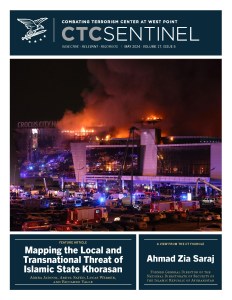From the Editor
In the wake of Islamic State Khorasan (ISK) attack on March 22 in Moscow and a wave of thwarted plots by the group in Europe, there is growing concern about the international terror threat the network poses. In the feature article, Amira Jadoon, Abdul Sayed, Lucas Webber, and Riccardo Valle assess that “ISK’s nearly decade-long presence in its traditional strongholds of Afghanistan and Pakistan, coupled with its expanding reach and appeal among Central Asian populations and its prioritization of inspiring and coordinating transnational attacks as part of its growth strategy, underscores the multifaceted and evolving nature of the threat posed by this resilient terrorist organization … Despite ISK’s recent decline in attacks in Afghanistan, the group retains the determination and capacity to conduct destabilizing high-profile attacks in multiple countries. The group remains resilient, but more worryingly, it has learned to adapt its strategy and tactics to fit evolving dynamics, and exploit local, regional, and global grievances and conflicts.”
Our interview is with Ahmad Zia Saraj who served as the General Director of the National Directorate of Security (NDS) of Afghanistan between September 2019 until the fall of Kabul on August 15, 2021. He recounts this turbulent period and the lessons learned. He warns that by using end-to-end-encryption, ISK can recruit, exchange information swiftly, plan, and execute international attacks. “Encrypted messaging apps have helped terrorists speed up operations, enhance operational security, save time, save travel costs, and to plan and execute and even monitor attacks in real time,” he says. “The NDS noticed that a newly recruited fighter does not need to physically attend a training camp to learn how to construct a bomb or how to target the enemy. All this can be done via a smart phone with less risk of exposure. Advancing technology has made it possible for someone to be trained in terrorist tactics in any part of the world, regardless of borders or travel restrictions. A terrorist in Afghanistan or Iraq can easily train another one in any part of the world.”
Finally, Pete Simi, Gina Ligon, Seamus Hughes, and Natalie Standridge quantify the rising threats to public officials in the United States by reviewing a decade of federal data. They write that: “A review of federal charges for the past decade highlights that the number of threats to public officials is growing. While 2013-2016 had an average of 38 federal charges per year, that number sharply increased to an average of 62 charges per year between 2017-2022. Across the time series, ideologically motivated threats, on average, accounted for almost half of the cases, and the portion steadily increased year over year. A preliminary review of cases from 2023 and 2024 shows that the number of federal prosecutions is on pace to hit new record highs. The rising threat level may produce significant consequences for the U.S. democratic system of governance.”
Paul Cruickshank, Editor in Chief
 Skip to content
Skip to content

